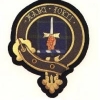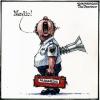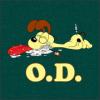Leaderboard
Popular Content
Showing content with the highest reputation on 11/14/2009 in all areas
-
To the OP: The IMPROVED OUTCOMES in the very short time that one attends to this or that patient in EMS is going to be VERY difficult to prove or disprove as most studies are "To Door" discharge, involving a huge cascade of Health Care Providers. To answer the question for the BASIC look to the pulse ox (if you have one) If you improve saturation you doing something for whatever the "slot" the patient one believes, ie say a COPD, with a Cardiac PmHx and throw in a community acquired pneumonia. But then withholding O2, with some study in hand and you may find your head in a guillotine for not following accepted practice, just saying. http://www.google.ca/search?hl=en&rlz=1C1CHMA_enCA347CA347&q=controversy+in+Oxygen+therapy+scholarly+studies&btnG=Search&meta=&aq=f&oq= As Vent notes: It would be a full time job just to read all the latest research about oxygen as it is used in various specialties and disease processes. Then introducing the PLACEBO effect, a hotly contested subject in latest issues of NEJM and the conclusions draw from meta studies vs some of the more dated studies that state empirically that this is even measurable. One certainly opens up a can of worms for the ethics types as delivery of Oxygen Therapy has never been studied, just medication(s) In regards to sword rattling, I provided for you as requested an anecdotal comment AND provided as much information concerning Pulmonary Physiology and the physics behind the rationale. I am and will continue to throw a gauntlet down in the spirit of an interesting debate, but taking it to my friend said level and emotional level ... FAIL. I do not have a degree I just make stuff up Mixing an "ethical dilemma" and the asking for "anecdotal comments" and toss in "human physiology and physics" you are going to get more conjecture than science. http://en.wikipedia.org/wiki/Ethical_dilemma1 point
-
Queen's English? AAAABBBBUUUUURRRCCCCEEEEEEEOOOOOOEEAAAAAAA Put 'em where you want in the book and you have the Queen's English.1 point
-
If STARS can do it why not Squint right? Oh it will go big. We just need to encourage people to let out their inner whacker. It’s kind of like our own little Canadian invasion here on EMTcity. I suspect that has something to do with senior forum members advocating better educational standards, and evidence based practice. I can only see the invasion continuing with the advent of an advocacy association. I like it. We should seek out leading Canadian MD’s in Emergency Medicine while we’re at it. Maybe they could help Dr. Bledsoe translate things into the Queen’s English? Many of us Canadians here on EMTcity do live in “Texas North” (Alberta) so we might even be able to forgo the Queen’s English. But “cotton kills”. We need to keep these folks around! Only if we get to eat the Moose first! I love moose steak. Might work. Paramedics for Professional Advancement and Evidence Based Practice (PPAEBP) maybe? I think this one sounds too “union” to be taken seriously. I can think of a few people deserving of such a patch. I might need to invest in a stab vest before I distribute them though. Ed1 point
-
Sorry buddy, but this is what starting a thread is all about. Each person has given you an answer/opinion and are attempting to back it up. Sit back, read, indulge, and lap up all the good info that is being discussed.1 point
-
To echo what tniugs- and I- said, lacking definitive evidence that supplemental O2 does any harm to the average prehospital patient, I think the placebo effect is HUGE. A person calls 911 for help, and assumes we can help them, or at least help ease their fears. Not every patient will have a dramatic turnaround like a narcotic OD, a reversal of hypoglycemia, or treatment for chest pain or pulmonary edema. Think about how often people ask how their BP is. Diagnostically it may have nothing to do with their situation, but it's something that most people understand. Think about how often people ask us what we think is going on with them. (No, we don't offer a diagnosis, but many times we can alleviate concerns with simple things like a kind word, a reassurance, or offer a possible, less serious reason for their symptoms.) If we tell them the O2 should help their nausea, anxiety, weakness, etc, then often times they accept it, calm down, and feel better. They arrive at the ER hopefully in a slightly better state physically and emotionally than when we arrived. The ER takes over and provides definitive care, but with all our fancy toys, medications, and training, I think too often we forget that the little things are what patients and their family remember about EMS. The end result is what counts, and the patient couldn't care less how many initials you have behind your name, that you just finished training on a new piece of equipment, or just reupped your ACLS certification. They simply want to feel better, and isn't that what this is all about? We are the first step of a continuum of care and I think that starting off on the right foot is an important part of feeling better. Several people have mentioned the mindset of a patient, and I agree that there are some people who are simply just too stubborn to die. We've all had the patients who defy all odds and should not be walking this earth- they conquer and recover from seemingly impossible situations time after time. We also have the people who succumb to illnesses and problems that are minor by comparison. I had a regular lady around 60 years old who had diabetes, CHF, MI's, CAD, one leg amputee- and on a drug store full of meds. Every several weeks she would call, and we would find her in the same situation- standing on one leg with her head in the freezer(she was convinced this made her feel better), with audible rales heard down the hall of her building, struggling to breathe. I intubated her 3 times(Did not have CPAP), and treated her with medications at least a dozen more. Most of the time she was breathing normally by the time we reached the ER and she always thanked us profusely. Her heart finally did give out, but from what I was told, it was actually sepsis that did her in. On several of her close calls, she did indeed tell us she was too ornery to die yet, and that she was simply not yet ready. We believed her.1 point
-
Clinical presentation and evaluation,and good observation in the field: Pallor, look to mucosal membranes (pull lower eye lid and observe the color) PMHX: say like a possible GI bleed upper or lower, sickle cell anemia,iron deficiency anemia,(a Pt. may be on iron suppliment (ask are they self medicating or are they prescribed by an MD and this some times is overlooked) heavy menstrual bleeding, in pernicious anemia (they receive Vitamin 12 on a regular basis)I could go on if you wish http://www.emedicinehealth.com/anemia/page2_em.htm hemacrit ok, lets understand that first, a pecentage of RBCs to Blood Plasma. http://www.google.ca/search?hl=en&rlz=1C1CHMA_enCA347CA347&defl=en&q=define:hematocrit&ei=jqb9Sq-PFIa0swPXs-WdCg&sa=X&oi=glossary_definition&ct=title&ved=0CAcQkAE So just what does your Board Certified MD wife do to correct this? If you go down the path before a clear understanding of terms well it could be a bumpy road ... just saying, again look to Vents Post re: types of Hemoglobin. I highly suspect you are referring my post split hairs or provide educational links and ask a simple question ? See Vents post: Where to start Ok I will do the leg work for you in regards to PaO2 this is an arterial sample, hence the a part, then analysed by a Clark electrode and actally measures the partial pressure of oxygen dissolved in the blood plasma a linear and direct relationship is made.(see chbare equation its the .0003 part) Then with all the factors ODC calculated and value is determined IN some ways bedside Pulse oximetry used to trending device is a extremely valuable tool, even in the light of an anemic hypoxia. http://www.google.ca/search?hl=en&rlz=1C1CHMA_enCA347CA347&q=pulse+oximetry+measures&meta=&aq=3&oq=pulse+oximetry http://www.google.ca/search?hl=en&rlz=1C1CHMA_enCA347CA347&q=pulse+oximetry&btnG=Search&meta=&aq=f&oq= One of the biggest concerns of mine In EMS is the serious misunderstanding between oxygenation and ventilation. So a little side bar, 2 years ago now RNs treated my mother post op major GI surgery, and even though I attempted to explain the difference of hypoventilation and oxygenation, studies indicate post op geriatric patient that supplemental O2 may increase mortality morbidity ... It did in My Mothers case, unrecognized Hypoventilation (but Pulse oximetry by their protocol, and all was good ) this lead to pre renal failure and my mother died, yes anecdotal but now clearly backed by EBM, btw the Board Certified MD Anesthesia did contribute in passing, urine output during surgery and post op (this on a RENAL unit to boot)then oxygen absorbortion atelectasis a post mortum finding. The RN said they were just following (protocol post surgery orders) (I was not in the employment as an RRT in that facility) the RNs have since received a very serious lecture since that time by the manager of respiratory department, the protocol has now been CHANGED, Respiratory Therapy department is now consulted. In part thanks to VentMedic an PM's I will always be in Vents Debt besides having a personal relashonship with the associate professor of ICU did not hurt either. There are much controversy now with researchers in regards to High levels of O2 vs Low levels in the CHF patient, just what I do is in cases of CHF and in Pulmonary odeama (when no anemia suspected) is watch the pulse ox trends. And as Ventmedic just touched upon many other areas, it boils down to this EMS initiates O2 therapy, RRTs then wean patients off O2, with all the hospital toys we get to play with: YES O2 is a toxic gas but not over the very short time in contact in the field, it has not been proven to be harmful (in vast majority of cases) that said the jury is not completely in lots of research to do yet. Did you note the time of my post? I get crabby when I am sleep deprived. Oh the O2 treats Nausea? Nope I disagree the EMS provider in that case used the gift of the GAB, body language, and confidence this relieved anxiety .... the placebo effect is huge and a tool in the EMS provider should NEVER forget. Anecdotally I have had some patients that have very seriously survived because they were convinced that they would, comments like hey I have seen way worse and their still walking and causing grief. One case comes to mind an elderly Woman on every Cardiac Med Know to man, in flash Pulmonary odeama ... 5 stents, LEF about 12% so I was honest with her, things are not looking great here: Her comment to me: cheers1 point
-
Where to start.... EMS generally does not have access to many factors like Hb (and different types), A-a, lactate level, SvO2 or even the ability to take the patient's temperature. Anxiety, "hyperventilation": Too many unknows as to if there is a medical underlying cause. Even electrolyte imbalances or an undiagnosed diabetic situation can cause a "mood swing" or "argument" to escalate out of control and what might appear as a "simple" anxiety could be a true medical situation. Thus, the word tachypnea should be used until a further exam is done. If the patient calms with O2, it could be because of comfort or because it is improving an underlying situation that is skewing the O2 consumption or Oxyhemoglobin Dissociation Curve. Pain Management: Does O2 improve the situation by alleviating the symptoms of increased O2 demand due to pain? Advanced practitioner should know this from critical care experience. There is now tons of lierature on this subject in Anethesia and Critical Care journals. Anyone that has worked with an ill or injured patient may see the O2 SpO2 plumment if not immediately but shortly there after if the pain issue is not treated. For EMT-Bs, treatment of pain is limited but the O2 may prevent the cascade of physiological events that occur with increase O2 demand and consumption due to pain. Once pain management is under control, O2 may not be required. Reseach: Again as I mentioned with pain management, there is an abundance of literature on the subject. However, everyone has a different theory and for every topic I can easily find 50 articles pro something and 50 articles con. For an Etomindate thread on this forum we had almost 50 articles just for a relatively short discusssion. In the larger Neuro ICUs, you may have 18 patients with different types of "Strokes" or head injuries and with them you may have 18 different O2 recipes to follow depending on whether a neurosurgeon, neurologist, Pulmonologist or Intensivist is following. It also depends on pre-existing or co-existing illness. Medical issues: There is now much research being done with Sepsis and many protocols run with a higher FiO2 depending on SvO2 which is again a factor that EMS providers do not have access to. Limitations: EMS medical directors that trained in large teaching hospitals got to see the philosophies of many different doctors managing patient in many different ICUs. Thus they also learned that one recipe may not fit all and due to limitations of training in EMS, if might be better to write protocols that error on a higher side of FiO2 rather than risk having EMT(P)s trying to figuure out the intricate details of a definitive diagnosis as it pertains to O2 consumption. EMT(P) training in the U.S. does not give much foundation for understanding sepsis, pain, neurological or many other medical issues. Even for those using a pulse oximeter, not many understand the Oxyhemoglobin curve, A-a gradient, sepsis or other disease processes that skew the abilities of a pulse oximeter besides the few obvious one taught in EMT(P) school. Some are mystified why we are intubating someone in the ED with a 100% SpO2 on a NRBM but don't understand that the A-a gradient of 400+ mmHg is bad. We also have had disagreements with ALS IFT teams who want to wean the FiO2 by SpO2 on a sepsis patient when the SvO2 is 50%. The same for the ETCO2 when there is a relatively large PetCO2 to PaCO2 gradient. There is also a lack of oxygen equipment education in EMS. A 4 L NC will not give the same FiO2 for someone with a MV of over 20 L/min as it will for someone with nice VTs of 500 breathing at a rate of 12. Also, the NRBM is truly not a high flow device by definition and has limitations. Thus, EMS medical directors, knowing the variations in current medical literature and research as well as that of the EMS providers, must write for what they feel may be the safest for the patient in the short term. Even if that agency has some very highly educated providers, for every 10 with education, there may be 50 more without. In the hospitals, we try to please everyone and I have probably 60 different protocols concerning the O2 management of various patients. This includes sepsis, ARDS, congenital anomalies, pulmonary HTN, neuro injuries, pneumothorax, post-op, pneumocephalus (including some caused by agressive CPAP on the wrong patient dx), cardiac of many types depending on pain, EF etc, and so on and so on. I really wish I could say that this recipe is better than that recipe but as soon as I do along comes a patient that demonstrates to me and others in the medical communities a differing opinion.1 point
-
-1 points
-
I tend to agree with ak here. After a non-stop night shift where you've already done 10 calls and finally get some rest, loud tones are the last thing you want to hear. When the call comes you have to go, but seeing as how alarm clocks and tones and related crap are probably the RUDEST devices ever made by humans, something softer might be a bit more appropriate. It's hard not to get mad at the tones, it's not their fault. It's some raisin who thinks because they haven't pooped properly in 4 days 3am is a good time to think it's an emergency. And of course it's even more infuriating when they have their jacket and shoes and everything on with their relative standing beside them saying "I'll just meet you at hospital" .... ok, bit of a rant there. But anyhow, soft tones and gentle lighting would I think help to reduce our frustration (HR and BP). Sounds a little more 'human friendly'.-1 points
-
-1 points




